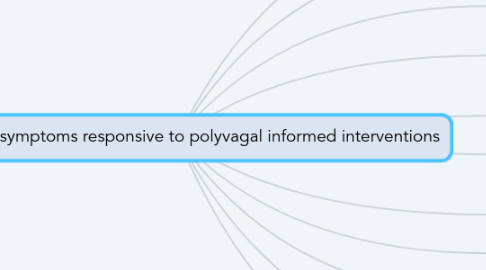
1. Respiratory System
1.1. Dyspnea
1.2. breathholding
1.3. shallow breathing
1.3.1. COPD
1.4. rapid breathing
1.5. temperature regulation
1.6. blood pH
1.7. immunity
2. Circulatory System
2.1. blood pressure
2.2. heart rate variability
2.3. vasoconstriction
2.4. vascular inflammation
2.4.1. vascular neuropathy
3. Renal/Urinary System
3.1. frequent urination
3.2. interstitial cystitis
3.3. toileting problems
3.4. incontinence
4. Skeletal System
4.1. arthritic process
5. Nervous System
5.1. Central Nervous System (Brain)
5.1.1. Brain
5.1.1.1. Forebrain
5.1.1.2. Brainstem
5.1.1.2.1. colliculi
5.1.1.3. Midbrain
5.1.1.3.1. periacqueductal gray (PAG)
5.1.1.3.2. hypothalamus
5.1.1.3.3. pituitary gland
5.1.1.4. Migraines
5.1.2. Spinal cord/nerves
5.2. Sensory system (sense organs and sensory nerves)
5.2.1. skin sensations
5.2.1.1. tactile
5.2.1.1.1. eating/feeding disorders
5.2.1.2. pain
5.2.1.2.1. hypersensitivity
5.2.1.3. itching
5.2.2. hearing
5.2.2.1. hypersensitivity
5.2.2.2. muffling/inability to hear voice
5.2.2.3. misphonia
5.2.2.4. tinnitus
5.2.2.5. auditory processing disorder
5.2.3. gustatory
5.2.3.1. distortions
5.2.3.2. reduced range of tastes
5.2.4. olfactory
5.2.4.1. distortions/loss of smell sense
5.2.4.2. hypersensitivity to smells
5.2.5. vision
5.2.5.1. sneezing reflex
5.2.5.2. light sensitivities
5.2.5.3. problems with focus/tracking
5.2.5.4. strabismus
5.2.6. Interoceptive
5.2.6.1. Pain, touch and temperature from larynx, lower pharynx, concha and skin of the external ear and ear canal, external surface of tympanic membrane, meninges of the posterior cranial fossa
5.2.6.2. Visceral sensory afferent esophagus, larynx, pharynx, cardiac, pulmonary, gastrointestinal viscera
5.3. Peripheral Nervous System (includes sensory motor)
5.3.1. Circadian rhythms
5.3.2. Sympathetic Nervous System
5.3.2.1. stress hormones
5.3.2.1.1. metabolic rate in cells
5.3.2.1.2. bronchodilation
5.3.2.1.3. breath rate
5.3.2.1.4. heart rate
5.3.2.1.5. redirection of blood flow to skeletal muscles
5.3.2.1.6. inhibition of digestion
5.3.2.1.7. skin tightening
5.3.2.1.8. blood pressure
5.3.2.2. regulation of homeostasis
5.3.2.2.1. Circadian Rhythm
5.3.2.3. Skeletal muscle system/Motor nerves
5.3.2.3.1. Reflex driven
5.3.2.3.2. Intention driven
5.3.3. Parasympathetic Nervous System (includes VAGUS nerve)
5.3.3.1. feeding
5.3.3.2. breeding
5.3.3.3. heart rate variability
5.3.3.4. bronchoconstriction
5.3.3.5. Smooth muscle systems
5.3.3.5.1. stretch receptors
5.3.3.6. Social Engagement system
5.3.3.6.1. muscles of neck
5.3.3.6.2. eyes
5.3.3.6.3. face
5.3.3.6.4. ears
5.3.3.6.5. pharnyx/larnyx
5.3.3.6.6. mouth/tongue/lips
6. Psycholgocial/cognitive/meaning system
6.1. anxiety
6.1.1. specific fears and phobias
6.1.2. obsessions
6.1.3. reactive movements
6.1.3.1. rocking
6.1.3.2. picking
6.1.3.3. flapping
6.1.3.4. spinning
6.1.4. rumination
6.1.5. distorted self-sense
6.1.5.1. disrupted interoception/chronic neuroception
6.1.5.2. anorexia
6.1.5.3. body dysmorphias
6.1.5.4. numbing
6.2. trauma sequela
6.2.1. flashbacks
6.2.2. nightmares
6.2.3. triggers/sensitivities
6.2.4. avoidance
6.2.5. disorganization
6.2.6. hypervigilance/reacitivity
6.2.7. sleep disruption
6.3. dissociation
6.3.1. defensive exclusion
6.3.2. numbing
6.3.3. blocking
6.4. reactive aggression
6.4.1. bullying (psychological-chronic)
6.4.2. peer conflict
6.4.3. physical attacks
6.4.3.1. kicking
6.4.3.2. hitting
6.4.3.3. biting
6.4.4. destruction of property
6.4.5. self injury
6.4.5.1. biting
6.4.5.2. cutting
6.4.5.3. headbanging
6.5. relationship/attachment disruption
6.5.1. anxious preoccupied
6.5.2. avoidant
6.5.3. disorganized
6.5.4. reactive
6.6. depression
6.6.1. isolating
6.6.2. anhedonia
6.6.3. irritability
6.6.4. reduced expressiveness
6.6.5. flat expression
6.6.6. disrupted sleep
6.6.7. psychomotor slowing
6.7. 'learned helplessnes'/negative expectations
6.8. behavioral reactivity (can include sensory)
6.8.1. hyperactivity
6.8.2. low frustration tolerance
6.8.3. meltdowns
6.8.4. low stress tolerance
6.8.5. irritability/mood lability
6.8.6. mania
6.9. cravings
6.10. perseveration
6.11. reduced emotional control/difficulty with self-soothing
6.12. language difficulty
6.12.1. following directions
6.12.2. coherency of narrative
6.12.3. absract language
6.12.4. vocabulary
6.12.5. pragmatics
6.13. poor memory skills
6.13.1. working memory
6.13.2. episodic memory
6.13.3. autobiographical memory
6.14. poor sequencing
6.15. disrupted social cognition
6.15.1. social reciprocity impairment
6.15.2. lack of attunement
6.15.3. impaired synchrony of interactions
6.15.4. low social motivation
6.15.5. lack of empathy
6.15.6. limited social thinking
6.16. difficulties with executive function
6.16.1. rigid rule-bound functioning
6.16.2. impulsivity
6.16.3. organization
6.16.3.1. thoughts
6.16.3.2. materials
6.16.4. decreased self-awareness/metacognition
6.16.5. difficulties with problem solving
6.16.6. time management
6.17. disorientation
6.18. illogical thinking
6.19. delayed processing speed
6.20. inattention
6.21. poor judgement and reasoning
7. Lympahtic/Immune System
7.1. lymph nodes/ducts
7.2. tonsils
7.3. thymus
7.4. spleen
7.5. bone marrow
8. Reproductive system
9. Digestive/Excretory System
9.1. gastric reflux
9.2. constipation
9.3. diarrhea
9.4. pediatric acute-onset neuropsychiatric syndrome (PANS)
9.5. pediatric autoimmune neuropsychiatric d/o associated with streptococcal infections (PANDAS)
9.6. toileting problems
9.7. yeast overgrowth
10. Endocrine System
10.1. Pineal Gland
10.1.1. Melatonin
10.2. Pituitary gland and hypthalamus
10.2.1. Growth Hormone
10.2.2. Oxytocin
10.2.2.1. prosocial behavior
10.3. Thyroid/Parathyroid Glands
10.4. Adrenal Glands
10.4.1. Noradrenaline
10.4.2. Adrenaline
10.4.2.1. low startle threshhold
10.4.2.2. flashbacks
10.4.2.3. hypervigilance
10.4.2.4. fight/flight behavior
10.4.2.5. alert behavior
10.4.2.6. adrenal fatigue
10.5. Pancreas
10.5.1. Insulin
10.5.2. Digestive enzymes
10.6. Ovaries
10.6.1. Estrogen
10.7. Testes
10.7.1. testosterone
11. Integumentary/Exocrine System
11.1. acne
11.2. allergies
11.3. skin sensitivities
11.3.1. itching
11.3.2. pain
11.3.3. aversive sensation
11.4. inflammation
11.4.1. Fibromyaligia
11.5. Skin
11.6. Nails
11.7. Glands
11.7.1. Sweat
11.7.2. Sebaceous
